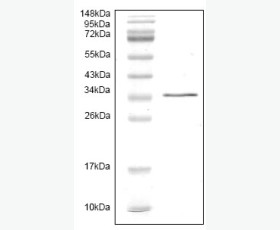Recombinant Human C-C Motif Chemokine 5/CCL5/RANTES
| Product name: | Recombinant Human C-C Motif Chemokine 5/CCL5/RANTES |
| Source: | E.coli |
| Purity: | Greater than 95% as determined by reducing SDS-PAGE. |
| Buffer Formulation: | Lyophilized from a 0.2 μm filtered solution of 20mM PB, 150mM NaCl, pH 7.4. |
| Applications: | Applications:SDS-PAGE; WB; ELISA; IP. |
| Storage: | Avoid repeated freeze/thaw cycles. Store at 2-8 oC for one month. Aliquot and store at -80 oC for 12 months. |
| UOM: | 100ug/50ug/200ug/1mg/1g |
| Source | E.coli |
| Description | Recombinant Human C-C Motif Chemokine 5 is produced by our E.coli expression system and the target gene encoding Ser24-Ser91 is expressed. |
| Names | C-C Motif Chemokine 5, EoCP, Eosinophil Chemotactic Cytokine, SIS-Delta, Small-Inducible Cytokine A5, T Cell-Specific Protein P228, TCP228, T-Cell-Specific Protein RANTES, CCL5, D17S136E, SCYA5 |
| Accession # | P13501 |
| Formulation | Lyophilized from a 0.2 μm filtered solution of 20mM PB, 150mM NaCl, pH 7.4. |
| Shipping |
The product is shipped at ambient temperature. |
| Reconstitution |
Always centrifuge tubes before opening. Do not mix by vortex or pipetting. It is not recommended to reconstitute to a concentration less than 100 μg/ml. Dissolve the lyophilized protein in ddH2O. Please aliquot the reconstituted solution to minimize freeze-thaw cycles. |
| Storage |
Lyophilized protein should be stored at < -20°C, though stable at room temperature for 3 weeks. Reconstituted protein solution can be stored at 4-7°C for 2-7 days. Aliquots of reconstituted samples are stable at < -20°C for 3 months. |
| Purity |
Greater than 95% as determined by reducing SDS-PAGE. |
| Endotoxin | Less than 0.1 ng/µg (1 IEU/µg) as determined by LAL test. |
| Amino Acid Sequence |
SPYSSDTTPCCFAYIARPLPRAHIKEYFYTSGKCSNPAVVFVTRKNRQVCANPEKKWVREYINSL EMS
|
| Background | Human Chemokine (C-C Motif) Ligand 5 (CCL5) plays an active role in recruiting leukocytes into inflammatory sites. CCL5 is secreted by many cell types at inflammatory sites and it exerts a wide range of activities through the receptors CCR1, CCR3, CCR4, and CCR5. N-Terminal truncated CCL5/RANTES, Met-RANTES, and amino-oxypentane (AOP)-RANTES exhibit antagonist or partial agonist functions on their receptors. CCL5/RANTES attracts different subtypes of leukocytes into inflamed tissue and intervenes in a wide range of allergic and autoimmune diseases. |














